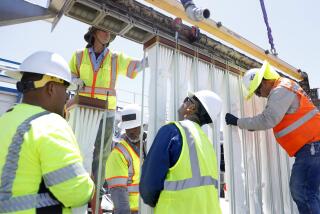Valley’s Broken Sewers Get High-Tech Surgery
The operation was a success.
The tiny, remote-control video camera had made its way through the newly installed plastic tubing, fabricated of advanced materials formulated especially for this purpose. A technician watched a video screen as he guided the camera carefully.
At previously determined intervals, a motorized cutting device precisely carved holes in the plastic to let liquids flow through.
Was it the latest in high-tech surgery?
Not quite.
In the sewer system beneath San Fernando Valley streets, crews are working daily to line and reinforce pipes damaged by the Northridge earthquake.
The workers are not, however, digging up the sewer pipes. Indeed, they are hardly even getting their hands dirty.
With advanced procedures involving high-pressure steam, new plastic formulations and a host of ingenious devices, the procedure is taking place with almost no mess and at a fraction of the time and cost it would have taken even two years ago.
“We are used to all this technology,” said crew supervisor George Beltran, who was overseeing a crew of seven working on a residential street on a recent morning. “But people come out of their houses all the time and want to know, ‘Why aren’t you digging down there? How do you do that?’ ”
The answers lie in a material called Fold and Formed PVC pipe, which is being installed in Valley sewer lines by local crews working for Insituform Technologies, a company based in Memphis, Tenn.
Insituform, which developed the folding pipe procedure, is one of several companies that received city contracts--supported by FEMA grants--to renovate the sewers. All the companies are using modern methods that eliminate the need for most digging.
“First we get access to the sewer pipe through the manhole, er, I mean maintenance hole,” said operations supervisor Joel Siperek.
The sewer pipe, about 5 feet down, is only 8 inches in diameter. The crew began by shooting steam, produced by a boiler on one of their trucks, into the pipe to clean a 300-foot section, the distance from one maintenance hole to the next.
Several days before, neighbors had received notices asking them not to use water during the day the crew would be working on their street.
The crew expected no problems in this lower-middle-class neighborhood. “It’s the richer areas that are more trouble,” said Siperek. “Some people just refuse to stop using water, even though we try to explain this is for their benefit and it’s only a few hours.”
Using water pressure, a thick wire was run through the pipe section. The video camera was then attached to the wire and as it moved down the pipe, a worker in one of the trucks swiveled its lens to check for unusual damage. He also noted the exact spot where home lines feed into the pipe.
After the camera was removed, the folded PVC pipe, stored on a large reel on one of the steam trucks, was moved into position. The pipe had been kept hot to ensure it was malleable.
A winch pulled the folded pipe along the length of the section; then more steam was shot through the plastic to bring it up to 150 degrees.
While waiting for the optimum temperature to be reached, crew member David Holguin opened the door to the steam boiler and quickly pulled out a packet covered in foil.
Another high-tech device?
“It’s lunch,” Holguin explained, passing out steaming hot pieces of pizza inside the foil.
With the temperature in the pipe at the optimum, a hard round ball covered in canvas--referred to by the crew as the “parachute”--was steam-propelled through the softened material to press it firmly against the existing terra cotta pipe, which Siperek guesses was laid in the late 1950s or early 1960s.
Water from a nearby hydrant was then pumped through the new lining to cool it.
More to Read
Sign up for Essential California
The most important California stories and recommendations in your inbox every morning.
You may occasionally receive promotional content from the Los Angeles Times.











